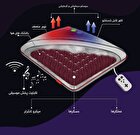Nanophotonic Upconversion Oxygen Sensors Developed by Iranian Researchers

These new generation of nanosensors are used for subcutaneous applications.
Compared with other types of sensors, nanophotonic sensors provide advantages of high sensitivity, low limit of detection, low crosstalk, strong detection multiplexing capability, high stability, immunity to electromagnetic interference, small size, and low cost.
Esmaeil Heidari, an assistant professor at the Faculty of Physics of Kharazmi University and the founder of the nanophotonic and optofluidic sensors laboratory, said lanthanide upconversion nanoemitters have been used to develop a new generation of nanophotonic oxygen sensors for subcutaneous applications, SNN reported.
Upconversion is a general term referring to nonlinear optical processes that convert two or more lower-energy pump photons to a higher-energy output photon.
Heidari pointed out that oxygen is an essential element for life on earth, and accurate measurement of its concentration is important in many applications, including medicine, biotechnology, and food and pharmaceutical industries.
He went on to say that in recent years, subcutaneously implantable sensors have received much attention in diagnosis and treatment due to the possibility of continuous and real-time measurement and compatibility with artificial intelligence platforms.
The limited penetration depth of visible light sources is one of the challenges of implantable photonic biosensors, he noted.
“Upconversion nanophotonic biosensors capable of being excited by near-infrared sources that are within the first optical window of tissue are a solution to increase penetration depth and reduce tissue destruction."
In this research, lanthanide upconversion nanoemitters have been used to develop a new generation of oxygen nanophotonic sensors for subcutaneous applications.
Properties such as high optical stability, non-dependence of the radiation spectrum on the dimensions of nanoparticles, and long radiation lifetime have made lanthanide nanoemitters of frequency upconversion be paid attention, Heidari highlighted.
Using the nanophotonic sensor, the oxygen concentration in air and water was measured with two technologies, time-resolved spectroscopy and intensity measurement.
The oxygen sensitivity of upconversion nanoparticles was shown by time-resolved spectroscopy.
The new generation of nanophotonic oxygen sensors is used for the treatment of diabetic patients as well as the treatment of cancerous tumors in hypoxic conditions.
4155/g

























